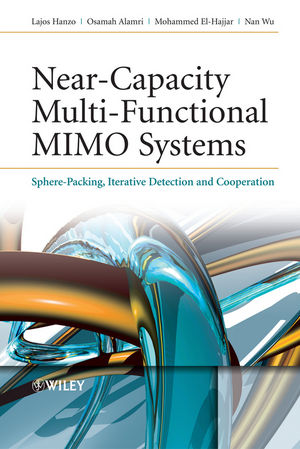Near-Capacity Multi-Functional MIMO Systems: Sphere-Packing, Iterative Detection and CooperationISBN: 978-0-470-77965-1
Hardcover
712 pages
June 2009, Wiley-IEEE Press
 |
||||||
OtherWiley?IEEE Press Books on Related Topics.
Preface.
Acknowledgments.
1 Problem Formulation, Objectives and Benefits.
1.1 TheWireless Channel and the Concept of Diversity.
1.2 Diversity and Multiplexing Trade-offs in Multi-functional MIMO Systems.
1.3 Coherent versus Non-coherent Detection for STBCs Using Co-located and Cooperative Antenna Elements.
1.4 Historical Perspective and State-of-the-Art Contributions.
1.5 Iterative Detection Schemes and their Convergence Analysis.
1.6 Outline and Novel Aspects of the Monograph.
Part I Coherent Versus Differential Turbo Detection of Sphere-packing-aided Single-user MIMO Systems.
List of Symbols in Part I.
2 Space-Time Block Code Design using Sphere Packing.
2.1 Introduction.
2.2 Design Criteria for Space-Time Signals.
2.3 Design Criteria for Time-correlated Fading Channels.
2.4 Orthogonal Space-Time Code Design using SP.
2.5 STBC-SP Performance.
2.6 Chapter Conclusions.
2.7 Chapter Summary.
3 Turbo Detection of Channel-coded STBC-SP Schemes.
3.1 Introduction.
3.2 System Overview.
3.3 Iterative Demapping.
3.4 Binary EXIT Chart Analysis.
3.5 Performance of Turbo-detected Bit-based STBC-SP Schemes.
3.6 Chapter Conclusions.
3.7 Chapter Summary.
4 Turbo Detection of Channel-coded DSTBC-SP Schemes.
4.1 Introduction.
4.2 Differential STBC using SP Modulation.
4.3 Bit-based RSC-coded Turbo-detected DSTBC-SP Scheme.
4.4 Chapter Conclusions.
4.5 Chapter Summary.
5 Three-stage Turbo-detected STBC-SP Schemes.
5.1 Introduction.
5.2 System Overview.
5.3 EXIT Chart Analysis.
5.4 Maximum Achievable Bandwidth Efficiency.
5.5 Performance of Three-stageTurbo-detected STBC-SP Schemes.
5.6 Chapter Conclusions.
5.7 Chapter Summary.
6 Symbol-based Channel-coded STBC-SP Schemes.
6.1 Introduction.
6.2 System Overview.
6.3 Symbol-based Iterative Decoding.
6.4 Non-binary EXIT Chart Analysis.
6.5 Performance of Bit-based and Symbol-based LDPC-coded STBC-SP Schemes.
6.6 Chapter Conclusions.
6.7 Chapter Summary.
Part II Coherent Versus Differential Turbo Detection of Single-user and Cooperative MIMOs.
List of Symbols in Part II.
7 Linear Dispersion Codes: An EXIT Chart Perspective.
7.1 Introduction and Outline.
7.2 Linear Dispersion Codes.
7.3 Link Between STBCs and LDCs.
7.4 EXIT-chart-based Design of LDCs.
7.5 EXIT-chart-based Design of IR-PLDCs.
7.6 Conclusion.
8 Differential Space-Time Block Codes: A Universal Approach.
8.1 Introduction and Outline.
8.2 System Model.
8.3 DOSTBCs.
8.4 DLDCs.
8.5 RSC-coded Precoder-aided DOSTBCs.
8.6 IRCC-coded Precoder-aided DLDCs.
8.7 Conclusion.
9 Cooperative Space-Time Block Codes.
9.1 Introduction and Outline.
9.2 Twin-layer CLDCs.
9.3 IRCC-coded Precoder-aided CLDCs.
9.4 Conclusion.
Part III Differential Turbo Detection of Multi-functional MIMO-aided Multi-user and Cooperative Systems.
List of Symbols in Part III.
10 Differential Space-Time Spreading.
10.1 Introduction.
10.2 DPSK.
10.3 DSTS Designusing Two Transmit Antennas.
10.4 DSTS Design Using Four Transmit Antennas.
10.5 Chapter Conclusions.
10.6 Chapter Summary.
11 Iterative Detection of Channel-coded DSTS Schemes.
11.1 Introduction.
11.2 Iterative Detection of RSC-coded DSTS Schemes.
11.3 Iterative Detection of RSC-coded and Unity-rate Precoded Four-antenna-aided DSTS-SP System.
11.4 Chapter Conclusions.
11.5 Chapter Summary.
12 Adaptive DSTS-assisted Iteratively Detected SP Modulation.
12.1 Introduction.
12.2 System Overview.
12.3 Adaptive DSTS-assisted SP Modulation.
12.4 VSF-based Adaptive Rate DSTS.
12.5 Variable-code-rate Iteratively Detected DSTS-SP System.
12.6 Results and Discussion.
12.7 Chapter Conclusion and Summary.
13 Layered Steered Space-Time Codes.
13.1 Introduction.
13.2 LSSTCs.
13.3 Capacity of LSSTCs.
13.4 Iterative Detection and EXIT Chart Analysis.
13.5 Results and Discussion.
13.6 Chapter Conclusions.
13.7 Chapter Summary.
14 DL LSSTS-aided Generalized MC DS-CDMA.
14.1 Introduction.
14.2 LSSTS-aided Generalized MCDS-CDMA.
14.3 Increasing the Number of Users by Employing TD and FD Spreading.
14.4 Iterative Detection and EXIT Chart Analysis.
14.5 Results and Discussion.
14.6 Chapter Conclusions.
14.7 Chapter Summary.
15 Distributed Turbo Coding.
15.1 Introduction.
15.2 Background of Cooperative Communications.
15.3 DTC.
15.4 Results and Discussion.
15.5 Chapter Conclusions.
15.6 Chapter Summary.
16 Conclusions and Future Research.
16.1 Summary and Conclusions.
16.2 Future Research Ideas.
16.3 Closing Remarks.
A Gray Mapping and AGM Schemes for SP Modulation of Size L=16.
B EXIT Charts of Various Bit-based Turbo-detected STBC-SP Schemes.
C EXIT Charts of Various Bit-based Turbo-detected DSTBC-SP Schemes.
D LDCs? ÷ for QPSK Modulation.
E DLDCs? ÷ for 2PAM Modulation.
F CLDCs? ÷1 and ÷2 for BPSK Modulation.
G Weighting Coefficient Vectors ë and ã.
H Gray Mapping and AGM Schemes for SP Modulation of Size L=16.
Glossary.
Bibliography.
Index.
Author Index.



